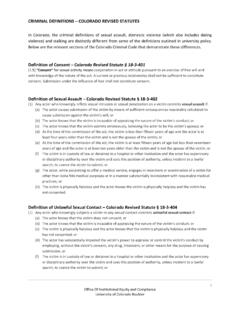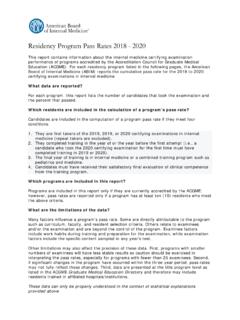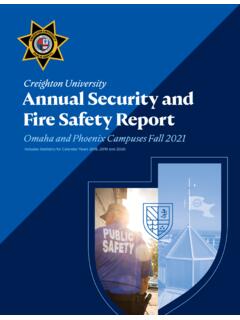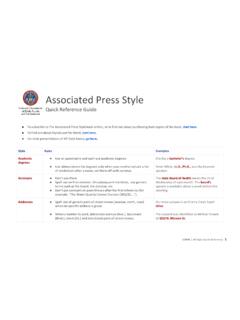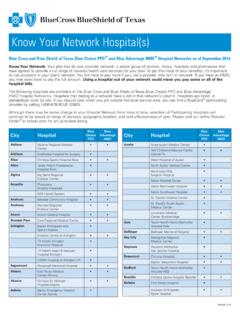Transcription of Veterinary Anesthetic and Analgesic Formulary
1 1 Veterinary Anesthetic and Analgesic Formulary 3rd Edition, Version G I. Introduction and Use of the UC denver Veterinary Formulary II. Anesthetic and Analgesic Considerations III. Species Specific Veterinary Formulary 1. Mouse 2. Rat 3. Neonatal Rodent 4. Guinea Pig 5. Chinchilla 6. Gerbil 7. Rabbit 8. Dog 9. Pig 10. Sheep 11. Non Pharmaceutical Grade Anesthetics IV. References I. Introduction and Use of the UC denver Formulary Basic Definitions: Anesthesia: central nervous system depression that provides amnesia, unconsciousness and immobility in response to a painful stimulation. Drugs that produce anesthesia may or may not provide analgesia (1, 2). Analgesia: The absence of pain in response to stimulation that would normally be painful. An Analgesic drug can provide analgesia by acting at the level of the central nervous system or at the site of inflammation to diminish or block pain signals (1, 2).
2 Sedation: A state of mental calmness, decreased response to environmental stimuli, and muscle relaxation. This state is characterized by suppression of spontaneous movement with maintenance of spinal reflexes (1). Animal anesthesia and analgesia are crucial components of an animal use protocol. This document is provided to aid in the design of an Anesthetic and Analgesic plan to prevent animal pain whenever possible. However, this document should not be perceived to replace consultation with the university s Veterinary staff. As required by law, the Veterinary staff should be consulted to assist in the planning of procedures where anesthetics and analgesics will be used to avoid or minimize discomfort, distress and pain in animals (3, 4). Prior to administration, all use of anesthetics and Analgesic are to be approved by the Institutional Animal Care and Use Committee (IACUC).
3 For each species listed in the Formulary , the most commonly used Anesthetic and Analgesic drugs used on this campus are highlighted. These drugs can be considered the front line of care. However, based on the research, procedure, and need, the most common drugs may not suffice and an individual drug or a combination of drugs may be indicated to provide the most safe and effective Anesthetic and Analgesic plan. 2 Dosages or dose ranges are obtained from a variety of laboratory animal medicine and Veterinary references which fail to precisely agree. Where dosage ranges are provided, the effective minimum and safely administered maximum are represented. Selection of dose can be based on Veterinary recommendation, literature references, or procedural experience. Yet, when listing these drugs in an animal use protocol, drugs should be listed with approximate dose ranges.
4 This provides flexibility for titration up or down for the individual animal or for the particular application. For Anesthetic drugs, the duration of action has not been provided. Duration of anesthesia is influenced by the drugs used, strain, age, sex, body weight, procedure performed and the amount of stimulus during the procedure. As a result, any published duration of action would be a generalization. For assistance in judging duration of action, consultation with a veterinarian is ideal when developing an Anesthetic regimen. Due to all the factors that influence duration of anesthesia, Anesthetic drugs should always be titrated to effect. If anesthesia is being maintained by a gas Anesthetic (eg. Isoflurane) titration of Anesthetic depth can be controlled almost immediately by adjusting the amount of Anesthetic gas being administered to the animal.
5 In addition, Anesthetic duration can be extended for as long as the Anesthetic gas is administered. In contrast, injectable anesthetics do not have this flexibility such that once a dose has been administered, it cannot be removed to end anesthesia to coincide with the end of the procedure. However, reversal drugs do exist for some of the drugs used in Anesthetic combinations such as Medetomidine, which is efficiently reversed by Atipamezole (see 2 antagonists below). In addition, injectable anesthetics may need to be re administered so the Anesthetic can initiate anesthesia if not achieved after the initial dose or accommodate the duration of the procedure. As a generalization, it is often recommended to re administer 25 30% of the initial dose of the injectable Anesthetic to lengthen the surgical anesthesia time. It is not acceptable to perform a surgical procedure unless the animal is fully anesthetized.
6 Thus, when laboratory experience with injectable anesthetics finds that the recommended dose ranges are consistently too high (prolonged anesthesia or long recovery) or too low (return of reflex requiring repeated administration of drugs) for the procedure, the Veterinary staff should be contacted. With Veterinary consultation, further flexibility can be provided to more accurately titrate dosages prior to submitting a protocol modification to the Institutional Animal Care and Use Committee. Independent of the method of anesthesia or duration of the procedure, animals should be monitored until awake, also referred to as Recovered. Recovery from anesthesia is indicated by the ability to right themselves when laid on their side, maintain a sternal body position, and demonstrate spontaneous movement in response to environmental stimulation such as cage manipulation.
7 Monitoring recovery allows for confirmation that animals will have negligible risk of harm from cage mates and be able/capable to reach water after hours. In addition, without monitoring the duration of recovery, Anesthetic dose cannot be titrated to effect which may result in prolonged anesthesia and recovery for a relatively brief procedure. As a result, plans for intra and post operative monitoring must be included in the IACUC protocol, and then practiced as written. For Analgesic drugs, doses and frequencies of administration are more difficult to gauge even with close clinical observation for discomfort. As a result, administration frequencies for analgesics are provided as strict guidelines supported by pain research in laboratory animal species or the standard of care in Veterinary medicine. If an alternative regimen is desired, consultation with a veterinarian is required.
8 A prime example of the importance of considering administration frequencies in Analgesic use is the consideration for overnight pain management. Most of the opioid analgesics (Buprenorphine, Fentanyl, Butorphenol, Oxymorphone, etc.) administered at 5:00 PM will not be effective at 8:00 AM the next 3 morning. Thus, administration after typical business hours, use of extended release formulations, and/or trans dermal patch can be considered depending on the species. Current longer lasting non steroidal anti inflammatory analgesics (NSAIDs) [Meloxicam, Carprofen, Flunixin, Ketoprofen, etc.] analgesics have longer durations of action than opioids, and can be administered in conjunction with opioids to increase potency of effect and duration of action. Independent of the Analgesic drug(s) selected, the ideal administration regimen of analgesia includes pre emptive ( pre surgical, pre procedural) Analgesic administration.
9 This allows the Analgesic to take effect prior to anesthesia so that the beneficial Analgesic effects are experienced as the anesthesia is wearing off. This method of pre emptive administration effectively prevents sensitization of pain sensory mechanisms which will prevent the ramp up of pain sensation. Once ramp up occurs, the threshold of pain stimulus is lowered thus requiring higher doses of Analgesic for longer duration to control pain and discomfort as compared to an animal where analgesics were provided before the procedure. Prior administration can effectively be achieved by administering the Analgesic regimen at least 30 min to 4 hrs prior to the potentially painful portion of the procedure. In rodent species, historically, the use of analgesics such as Acetaminophen (Children s Tylenol Elixir) and Ibuprofen (Children s Advil Elixir) have been administered in the drinking water for post surgical procedures.
10 This was performed based on the assumption that continuous administration of drug by consumption in the water would provide a hands off, stress free, continuously administered level of Analgesic therapy. With continued investigation, it has been demonstrated that water and food consumption post surgically and/or post anesthesia are neither constant nor consistent (5 8). As a result, analgesics may not be consumed by the patient. Confirmed administration is encouraged by routes such as injection or oral/gastric gavage to insure that the patient receives the appropriate dose of medication to better manage discomfort. Independent of the quality of design and integration of an Anesthetic and Analgesic plan into a research protocol, that plan is only as good as the skill and care with which it is applied. Training is available from the Veterinary staff of the Office of Laboratory Animal Resources through routinely scheduled classes or by request for all personnel that work with laboratory animals.

